Service Encounter and Critical Analysis using RATER Model: A Case Study of Qantas Airlines
VerifiedAdded on 2023/06/10
|12
|3720
|373
AI Summary
This report is a case study of a service encounter with Qantas Airlines and a critical analysis using RATER model. The report highlights the importance of customer service and suggests recommendations for service organizations to improve their services. The report covers the subject of Service Marketing and Concepts and is relevant for students pursuing Bachelor of Hospitality Management. The course code and college/university are not mentioned.
Contribute Materials
Your contribution can guide someone’s learning journey. Share your
documents today.
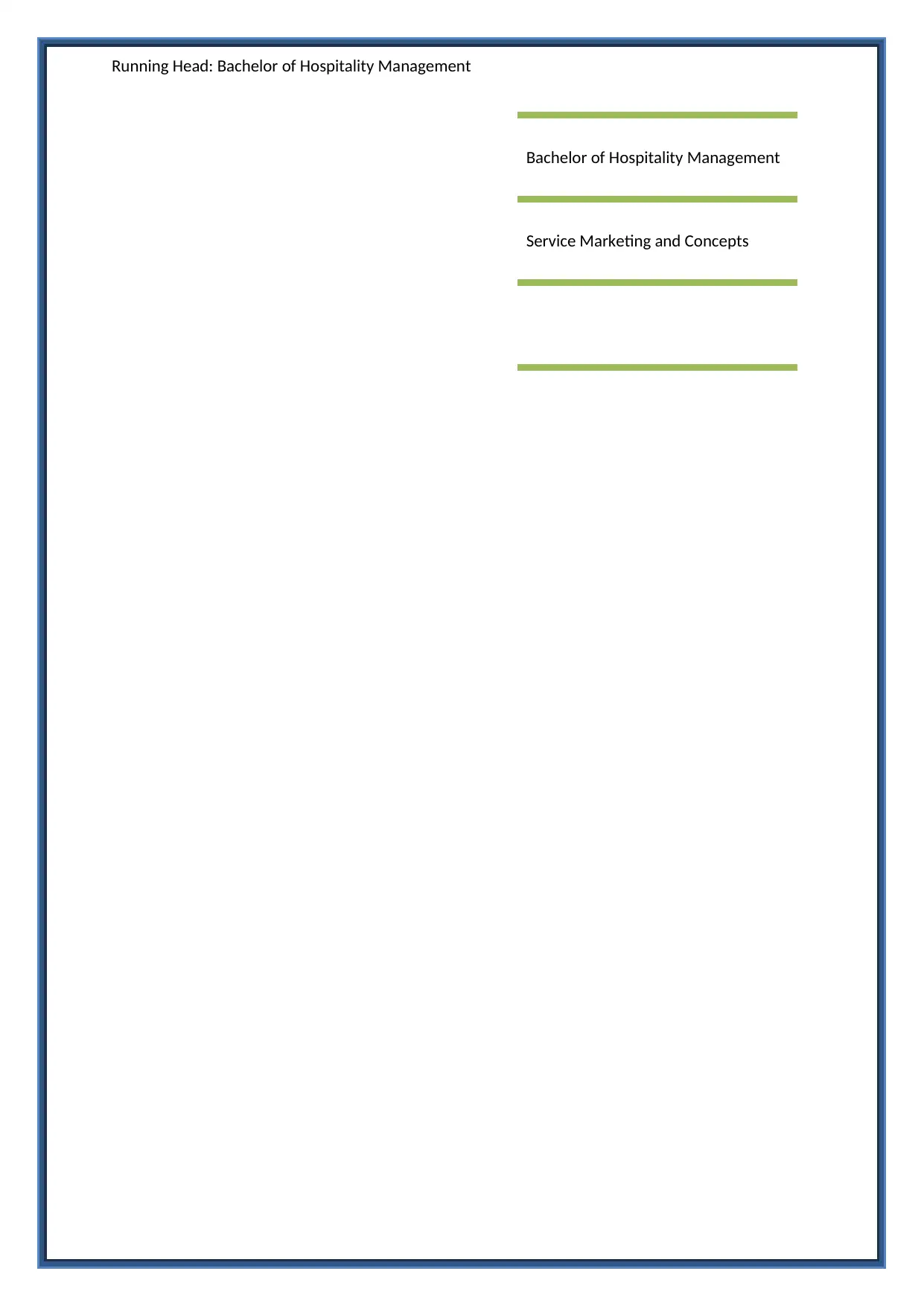
Running Head: Bachelor of Hospitality Management
Bachelor of Hospitality Management
Service Marketing and Concepts
Bachelor of Hospitality Management
Service Marketing and Concepts
Secure Best Marks with AI Grader
Need help grading? Try our AI Grader for instant feedback on your assignments.
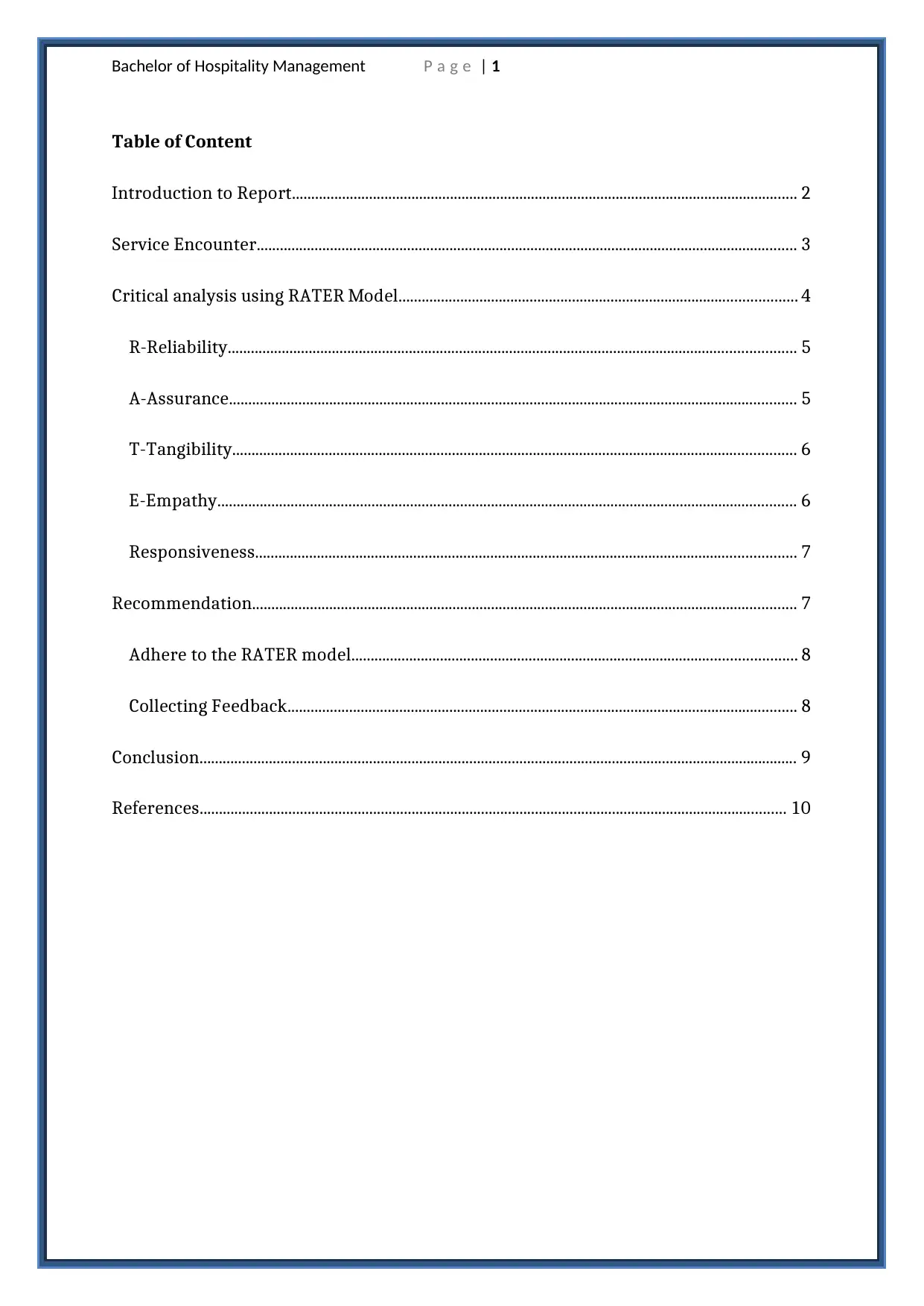
Bachelor of Hospitality Management P a g e | 1
Table of Content
Introduction to Report................................................................................................................................... 2
Service Encounter............................................................................................................................................ 3
Critical analysis using RATER Model....................................................................................................... 4
R-Reliability................................................................................................................................................... 5
A-Assurance................................................................................................................................................... 5
T-Tangibility.................................................................................................................................................. 6
E-Empathy...................................................................................................................................................... 6
Responsiveness............................................................................................................................................ 7
Recommendation............................................................................................................................................. 7
Adhere to the RATER model................................................................................................................... 8
Collecting Feedback.................................................................................................................................... 8
Conclusion........................................................................................................................................................... 9
References........................................................................................................................................................ 10
Table of Content
Introduction to Report................................................................................................................................... 2
Service Encounter............................................................................................................................................ 3
Critical analysis using RATER Model....................................................................................................... 4
R-Reliability................................................................................................................................................... 5
A-Assurance................................................................................................................................................... 5
T-Tangibility.................................................................................................................................................. 6
E-Empathy...................................................................................................................................................... 6
Responsiveness............................................................................................................................................ 7
Recommendation............................................................................................................................................. 7
Adhere to the RATER model................................................................................................................... 8
Collecting Feedback.................................................................................................................................... 8
Conclusion........................................................................................................................................................... 9
References........................................................................................................................................................ 10
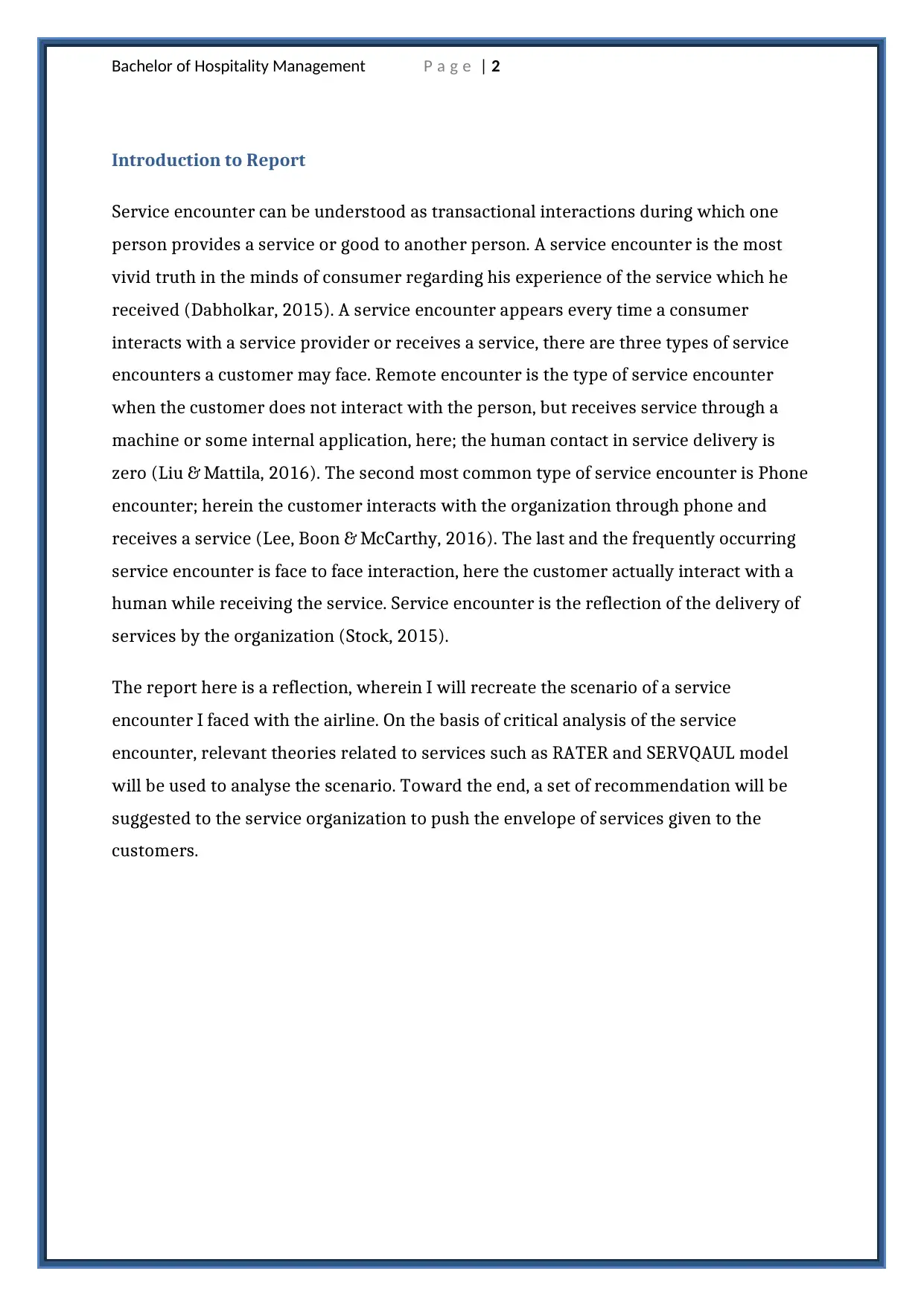
Bachelor of Hospitality Management P a g e | 2
Introduction to Report
Service encounter can be understood as transactional interactions during which one
person provides a service or good to another person. A service encounter is the most
vivid truth in the minds of consumer regarding his experience of the service which he
received (Dabholkar, 2015). A service encounter appears every time a consumer
interacts with a service provider or receives a service, there are three types of service
encounters a customer may face. Remote encounter is the type of service encounter
when the customer does not interact with the person, but receives service through a
machine or some internal application, here; the human contact in service delivery is
zero (Liu & Mattila, 2016). The second most common type of service encounter is Phone
encounter; herein the customer interacts with the organization through phone and
receives a service (Lee, Boon & McCarthy, 2016). The last and the frequently occurring
service encounter is face to face interaction, here the customer actually interact with a
human while receiving the service. Service encounter is the reflection of the delivery of
services by the organization (Stock, 2015).
The report here is a reflection, wherein I will recreate the scenario of a service
encounter I faced with the airline. On the basis of critical analysis of the service
encounter, relevant theories related to services such as RATER and SERVQAUL model
will be used to analyse the scenario. Toward the end, a set of recommendation will be
suggested to the service organization to push the envelope of services given to the
customers.
Introduction to Report
Service encounter can be understood as transactional interactions during which one
person provides a service or good to another person. A service encounter is the most
vivid truth in the minds of consumer regarding his experience of the service which he
received (Dabholkar, 2015). A service encounter appears every time a consumer
interacts with a service provider or receives a service, there are three types of service
encounters a customer may face. Remote encounter is the type of service encounter
when the customer does not interact with the person, but receives service through a
machine or some internal application, here; the human contact in service delivery is
zero (Liu & Mattila, 2016). The second most common type of service encounter is Phone
encounter; herein the customer interacts with the organization through phone and
receives a service (Lee, Boon & McCarthy, 2016). The last and the frequently occurring
service encounter is face to face interaction, here the customer actually interact with a
human while receiving the service. Service encounter is the reflection of the delivery of
services by the organization (Stock, 2015).
The report here is a reflection, wherein I will recreate the scenario of a service
encounter I faced with the airline. On the basis of critical analysis of the service
encounter, relevant theories related to services such as RATER and SERVQAUL model
will be used to analyse the scenario. Toward the end, a set of recommendation will be
suggested to the service organization to push the envelope of services given to the
customers.
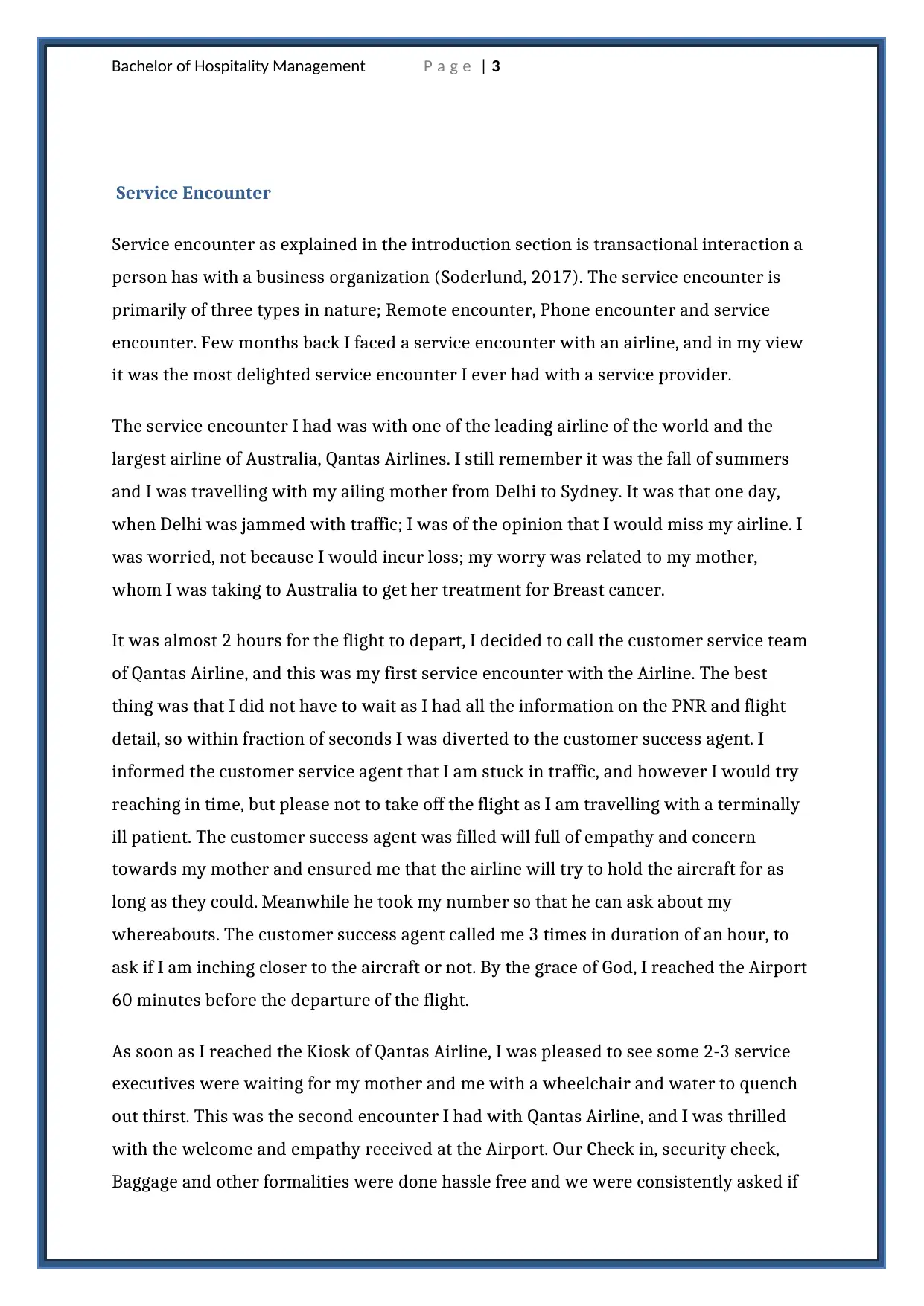
Bachelor of Hospitality Management P a g e | 3
Service Encounter
Service encounter as explained in the introduction section is transactional interaction a
person has with a business organization (Soderlund, 2017). The service encounter is
primarily of three types in nature; Remote encounter, Phone encounter and service
encounter. Few months back I faced a service encounter with an airline, and in my view
it was the most delighted service encounter I ever had with a service provider.
The service encounter I had was with one of the leading airline of the world and the
largest airline of Australia, Qantas Airlines. I still remember it was the fall of summers
and I was travelling with my ailing mother from Delhi to Sydney. It was that one day,
when Delhi was jammed with traffic; I was of the opinion that I would miss my airline. I
was worried, not because I would incur loss; my worry was related to my mother,
whom I was taking to Australia to get her treatment for Breast cancer.
It was almost 2 hours for the flight to depart, I decided to call the customer service team
of Qantas Airline, and this was my first service encounter with the Airline. The best
thing was that I did not have to wait as I had all the information on the PNR and flight
detail, so within fraction of seconds I was diverted to the customer success agent. I
informed the customer service agent that I am stuck in traffic, and however I would try
reaching in time, but please not to take off the flight as I am travelling with a terminally
ill patient. The customer success agent was filled will full of empathy and concern
towards my mother and ensured me that the airline will try to hold the aircraft for as
long as they could. Meanwhile he took my number so that he can ask about my
whereabouts. The customer success agent called me 3 times in duration of an hour, to
ask if I am inching closer to the aircraft or not. By the grace of God, I reached the Airport
60 minutes before the departure of the flight.
As soon as I reached the Kiosk of Qantas Airline, I was pleased to see some 2-3 service
executives were waiting for my mother and me with a wheelchair and water to quench
out thirst. This was the second encounter I had with Qantas Airline, and I was thrilled
with the welcome and empathy received at the Airport. Our Check in, security check,
Baggage and other formalities were done hassle free and we were consistently asked if
Service Encounter
Service encounter as explained in the introduction section is transactional interaction a
person has with a business organization (Soderlund, 2017). The service encounter is
primarily of three types in nature; Remote encounter, Phone encounter and service
encounter. Few months back I faced a service encounter with an airline, and in my view
it was the most delighted service encounter I ever had with a service provider.
The service encounter I had was with one of the leading airline of the world and the
largest airline of Australia, Qantas Airlines. I still remember it was the fall of summers
and I was travelling with my ailing mother from Delhi to Sydney. It was that one day,
when Delhi was jammed with traffic; I was of the opinion that I would miss my airline. I
was worried, not because I would incur loss; my worry was related to my mother,
whom I was taking to Australia to get her treatment for Breast cancer.
It was almost 2 hours for the flight to depart, I decided to call the customer service team
of Qantas Airline, and this was my first service encounter with the Airline. The best
thing was that I did not have to wait as I had all the information on the PNR and flight
detail, so within fraction of seconds I was diverted to the customer success agent. I
informed the customer service agent that I am stuck in traffic, and however I would try
reaching in time, but please not to take off the flight as I am travelling with a terminally
ill patient. The customer success agent was filled will full of empathy and concern
towards my mother and ensured me that the airline will try to hold the aircraft for as
long as they could. Meanwhile he took my number so that he can ask about my
whereabouts. The customer success agent called me 3 times in duration of an hour, to
ask if I am inching closer to the aircraft or not. By the grace of God, I reached the Airport
60 minutes before the departure of the flight.
As soon as I reached the Kiosk of Qantas Airline, I was pleased to see some 2-3 service
executives were waiting for my mother and me with a wheelchair and water to quench
out thirst. This was the second encounter I had with Qantas Airline, and I was thrilled
with the welcome and empathy received at the Airport. Our Check in, security check,
Baggage and other formalities were done hassle free and we were consistently asked if
Secure Best Marks with AI Grader
Need help grading? Try our AI Grader for instant feedback on your assignments.
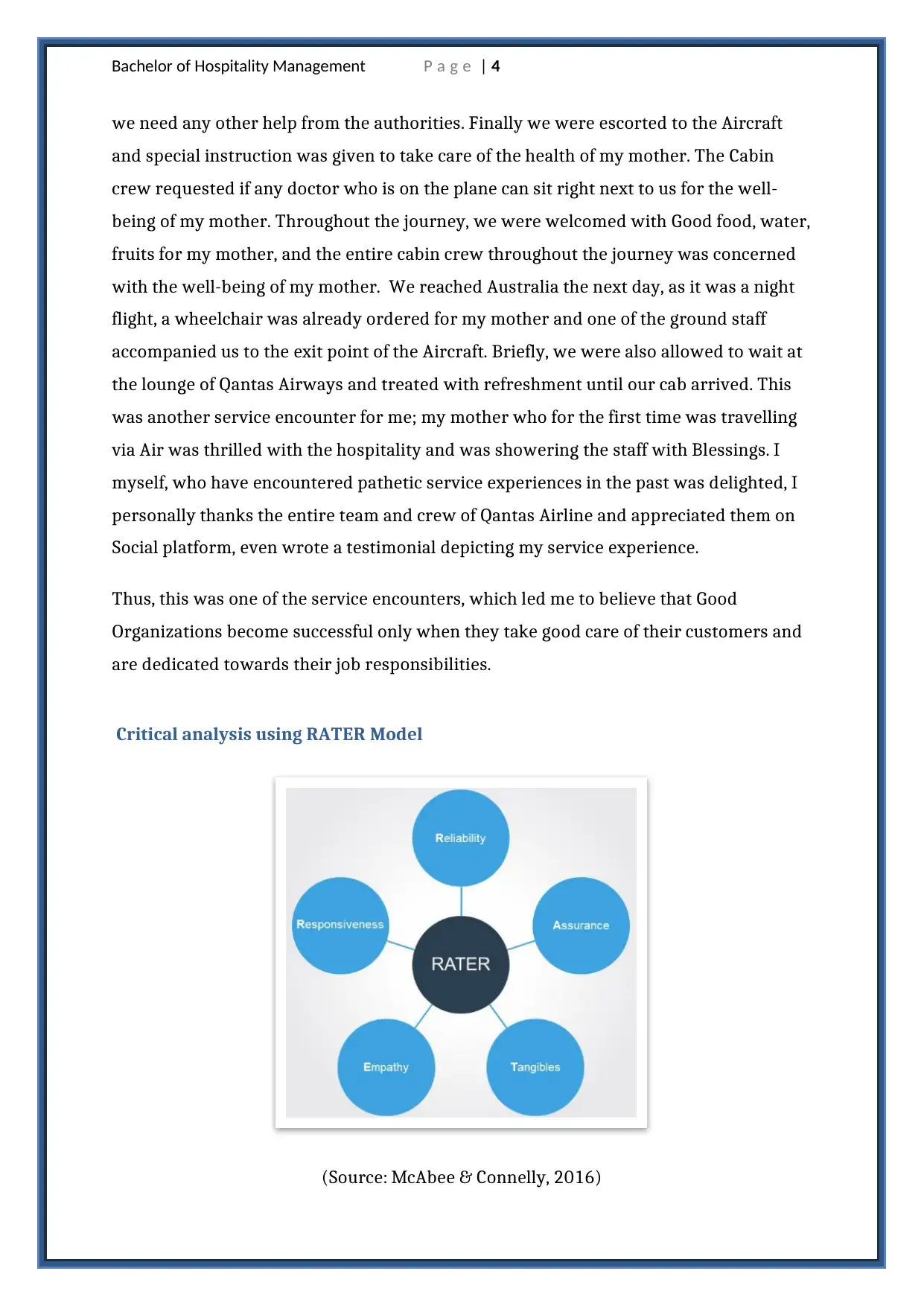
Bachelor of Hospitality Management P a g e | 4
we need any other help from the authorities. Finally we were escorted to the Aircraft
and special instruction was given to take care of the health of my mother. The Cabin
crew requested if any doctor who is on the plane can sit right next to us for the well-
being of my mother. Throughout the journey, we were welcomed with Good food, water,
fruits for my mother, and the entire cabin crew throughout the journey was concerned
with the well-being of my mother. We reached Australia the next day, as it was a night
flight, a wheelchair was already ordered for my mother and one of the ground staff
accompanied us to the exit point of the Aircraft. Briefly, we were also allowed to wait at
the lounge of Qantas Airways and treated with refreshment until our cab arrived. This
was another service encounter for me; my mother who for the first time was travelling
via Air was thrilled with the hospitality and was showering the staff with Blessings. I
myself, who have encountered pathetic service experiences in the past was delighted, I
personally thanks the entire team and crew of Qantas Airline and appreciated them on
Social platform, even wrote a testimonial depicting my service experience.
Thus, this was one of the service encounters, which led me to believe that Good
Organizations become successful only when they take good care of their customers and
are dedicated towards their job responsibilities.
Critical analysis using RATER Model
(Source: McAbee & Connelly, 2016)
we need any other help from the authorities. Finally we were escorted to the Aircraft
and special instruction was given to take care of the health of my mother. The Cabin
crew requested if any doctor who is on the plane can sit right next to us for the well-
being of my mother. Throughout the journey, we were welcomed with Good food, water,
fruits for my mother, and the entire cabin crew throughout the journey was concerned
with the well-being of my mother. We reached Australia the next day, as it was a night
flight, a wheelchair was already ordered for my mother and one of the ground staff
accompanied us to the exit point of the Aircraft. Briefly, we were also allowed to wait at
the lounge of Qantas Airways and treated with refreshment until our cab arrived. This
was another service encounter for me; my mother who for the first time was travelling
via Air was thrilled with the hospitality and was showering the staff with Blessings. I
myself, who have encountered pathetic service experiences in the past was delighted, I
personally thanks the entire team and crew of Qantas Airline and appreciated them on
Social platform, even wrote a testimonial depicting my service experience.
Thus, this was one of the service encounters, which led me to believe that Good
Organizations become successful only when they take good care of their customers and
are dedicated towards their job responsibilities.
Critical analysis using RATER Model
(Source: McAbee & Connelly, 2016)
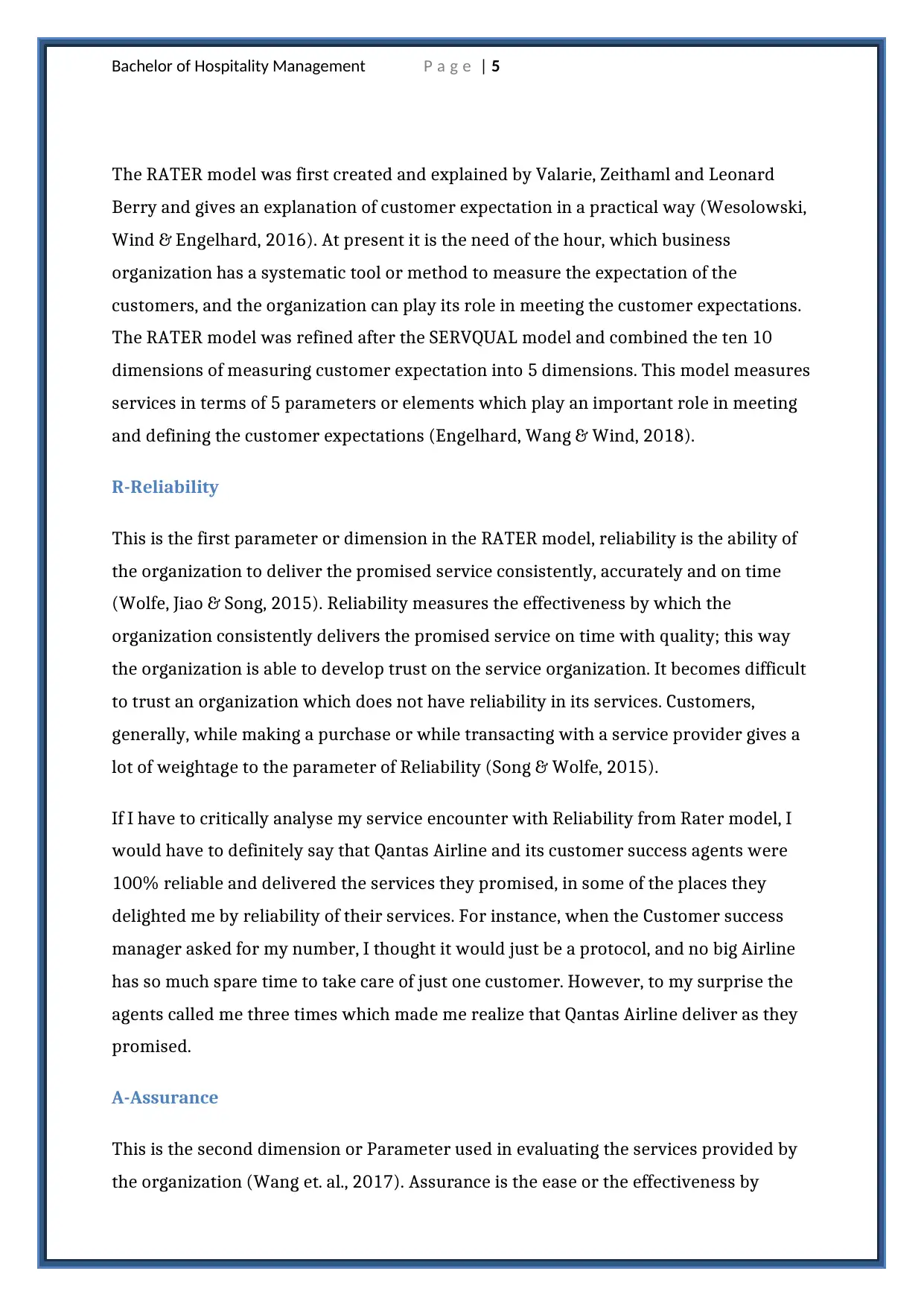
Bachelor of Hospitality Management P a g e | 5
The RATER model was first created and explained by Valarie, Zeithaml and Leonard
Berry and gives an explanation of customer expectation in a practical way (Wesolowski,
Wind & Engelhard, 2016). At present it is the need of the hour, which business
organization has a systematic tool or method to measure the expectation of the
customers, and the organization can play its role in meeting the customer expectations.
The RATER model was refined after the SERVQUAL model and combined the ten 10
dimensions of measuring customer expectation into 5 dimensions. This model measures
services in terms of 5 parameters or elements which play an important role in meeting
and defining the customer expectations (Engelhard, Wang & Wind, 2018).
R-Reliability
This is the first parameter or dimension in the RATER model, reliability is the ability of
the organization to deliver the promised service consistently, accurately and on time
(Wolfe, Jiao & Song, 2015). Reliability measures the effectiveness by which the
organization consistently delivers the promised service on time with quality; this way
the organization is able to develop trust on the service organization. It becomes difficult
to trust an organization which does not have reliability in its services. Customers,
generally, while making a purchase or while transacting with a service provider gives a
lot of weightage to the parameter of Reliability (Song & Wolfe, 2015).
If I have to critically analyse my service encounter with Reliability from Rater model, I
would have to definitely say that Qantas Airline and its customer success agents were
100% reliable and delivered the services they promised, in some of the places they
delighted me by reliability of their services. For instance, when the Customer success
manager asked for my number, I thought it would just be a protocol, and no big Airline
has so much spare time to take care of just one customer. However, to my surprise the
agents called me three times which made me realize that Qantas Airline deliver as they
promised.
A-Assurance
This is the second dimension or Parameter used in evaluating the services provided by
the organization (Wang et. al., 2017). Assurance is the ease or the effectiveness by
The RATER model was first created and explained by Valarie, Zeithaml and Leonard
Berry and gives an explanation of customer expectation in a practical way (Wesolowski,
Wind & Engelhard, 2016). At present it is the need of the hour, which business
organization has a systematic tool or method to measure the expectation of the
customers, and the organization can play its role in meeting the customer expectations.
The RATER model was refined after the SERVQUAL model and combined the ten 10
dimensions of measuring customer expectation into 5 dimensions. This model measures
services in terms of 5 parameters or elements which play an important role in meeting
and defining the customer expectations (Engelhard, Wang & Wind, 2018).
R-Reliability
This is the first parameter or dimension in the RATER model, reliability is the ability of
the organization to deliver the promised service consistently, accurately and on time
(Wolfe, Jiao & Song, 2015). Reliability measures the effectiveness by which the
organization consistently delivers the promised service on time with quality; this way
the organization is able to develop trust on the service organization. It becomes difficult
to trust an organization which does not have reliability in its services. Customers,
generally, while making a purchase or while transacting with a service provider gives a
lot of weightage to the parameter of Reliability (Song & Wolfe, 2015).
If I have to critically analyse my service encounter with Reliability from Rater model, I
would have to definitely say that Qantas Airline and its customer success agents were
100% reliable and delivered the services they promised, in some of the places they
delighted me by reliability of their services. For instance, when the Customer success
manager asked for my number, I thought it would just be a protocol, and no big Airline
has so much spare time to take care of just one customer. However, to my surprise the
agents called me three times which made me realize that Qantas Airline deliver as they
promised.
A-Assurance
This is the second dimension or Parameter used in evaluating the services provided by
the organization (Wang et. al., 2017). Assurance is the ease or the effectiveness by
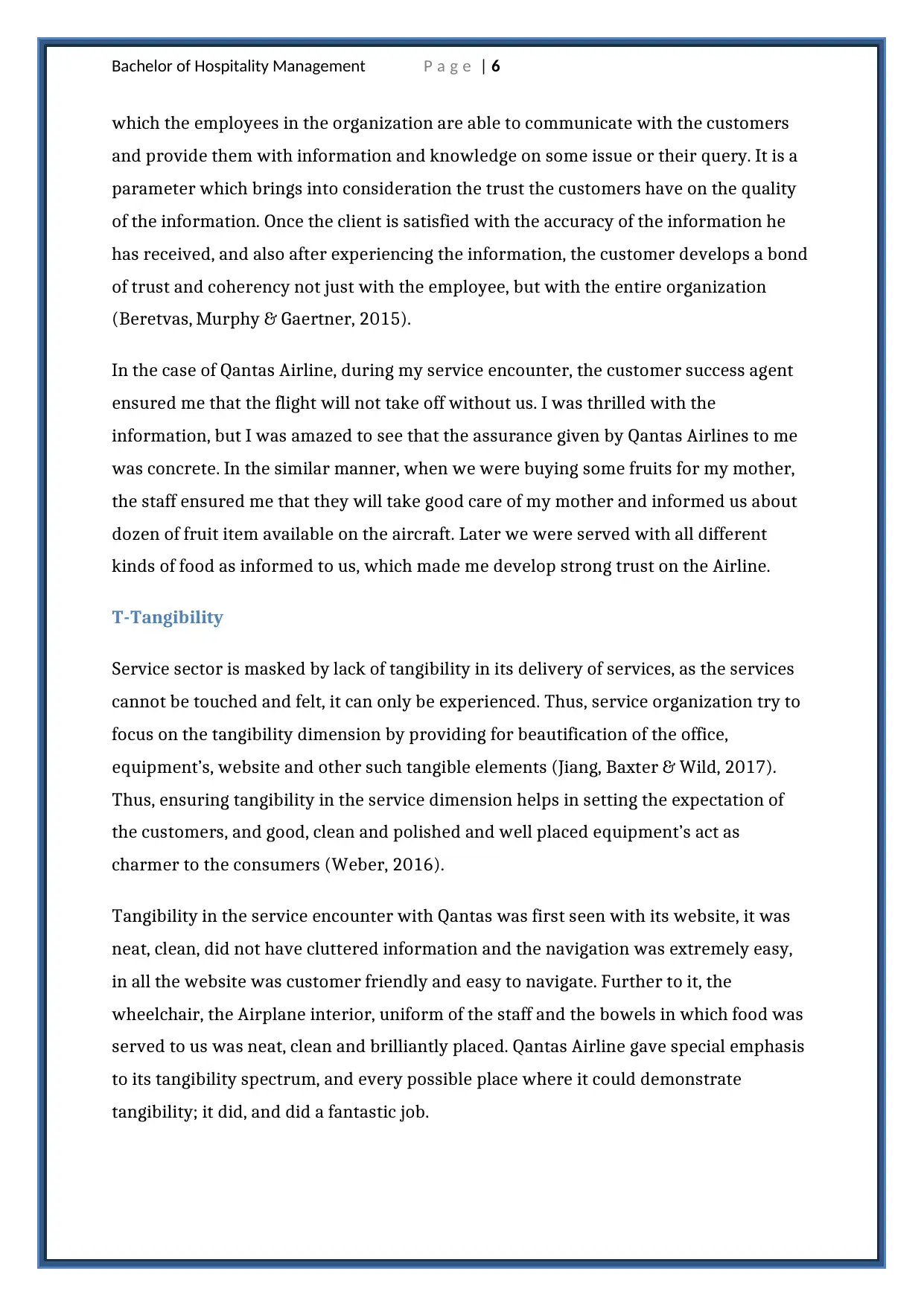
Bachelor of Hospitality Management P a g e | 6
which the employees in the organization are able to communicate with the customers
and provide them with information and knowledge on some issue or their query. It is a
parameter which brings into consideration the trust the customers have on the quality
of the information. Once the client is satisfied with the accuracy of the information he
has received, and also after experiencing the information, the customer develops a bond
of trust and coherency not just with the employee, but with the entire organization
(Beretvas, Murphy & Gaertner, 2015).
In the case of Qantas Airline, during my service encounter, the customer success agent
ensured me that the flight will not take off without us. I was thrilled with the
information, but I was amazed to see that the assurance given by Qantas Airlines to me
was concrete. In the similar manner, when we were buying some fruits for my mother,
the staff ensured me that they will take good care of my mother and informed us about
dozen of fruit item available on the aircraft. Later we were served with all different
kinds of food as informed to us, which made me develop strong trust on the Airline.
T-Tangibility
Service sector is masked by lack of tangibility in its delivery of services, as the services
cannot be touched and felt, it can only be experienced. Thus, service organization try to
focus on the tangibility dimension by providing for beautification of the office,
equipment’s, website and other such tangible elements (Jiang, Baxter & Wild, 2017).
Thus, ensuring tangibility in the service dimension helps in setting the expectation of
the customers, and good, clean and polished and well placed equipment’s act as
charmer to the consumers (Weber, 2016).
Tangibility in the service encounter with Qantas was first seen with its website, it was
neat, clean, did not have cluttered information and the navigation was extremely easy,
in all the website was customer friendly and easy to navigate. Further to it, the
wheelchair, the Airplane interior, uniform of the staff and the bowels in which food was
served to us was neat, clean and brilliantly placed. Qantas Airline gave special emphasis
to its tangibility spectrum, and every possible place where it could demonstrate
tangibility; it did, and did a fantastic job.
which the employees in the organization are able to communicate with the customers
and provide them with information and knowledge on some issue or their query. It is a
parameter which brings into consideration the trust the customers have on the quality
of the information. Once the client is satisfied with the accuracy of the information he
has received, and also after experiencing the information, the customer develops a bond
of trust and coherency not just with the employee, but with the entire organization
(Beretvas, Murphy & Gaertner, 2015).
In the case of Qantas Airline, during my service encounter, the customer success agent
ensured me that the flight will not take off without us. I was thrilled with the
information, but I was amazed to see that the assurance given by Qantas Airlines to me
was concrete. In the similar manner, when we were buying some fruits for my mother,
the staff ensured me that they will take good care of my mother and informed us about
dozen of fruit item available on the aircraft. Later we were served with all different
kinds of food as informed to us, which made me develop strong trust on the Airline.
T-Tangibility
Service sector is masked by lack of tangibility in its delivery of services, as the services
cannot be touched and felt, it can only be experienced. Thus, service organization try to
focus on the tangibility dimension by providing for beautification of the office,
equipment’s, website and other such tangible elements (Jiang, Baxter & Wild, 2017).
Thus, ensuring tangibility in the service dimension helps in setting the expectation of
the customers, and good, clean and polished and well placed equipment’s act as
charmer to the consumers (Weber, 2016).
Tangibility in the service encounter with Qantas was first seen with its website, it was
neat, clean, did not have cluttered information and the navigation was extremely easy,
in all the website was customer friendly and easy to navigate. Further to it, the
wheelchair, the Airplane interior, uniform of the staff and the bowels in which food was
served to us was neat, clean and brilliantly placed. Qantas Airline gave special emphasis
to its tangibility spectrum, and every possible place where it could demonstrate
tangibility; it did, and did a fantastic job.
Paraphrase This Document
Need a fresh take? Get an instant paraphrase of this document with our AI Paraphraser
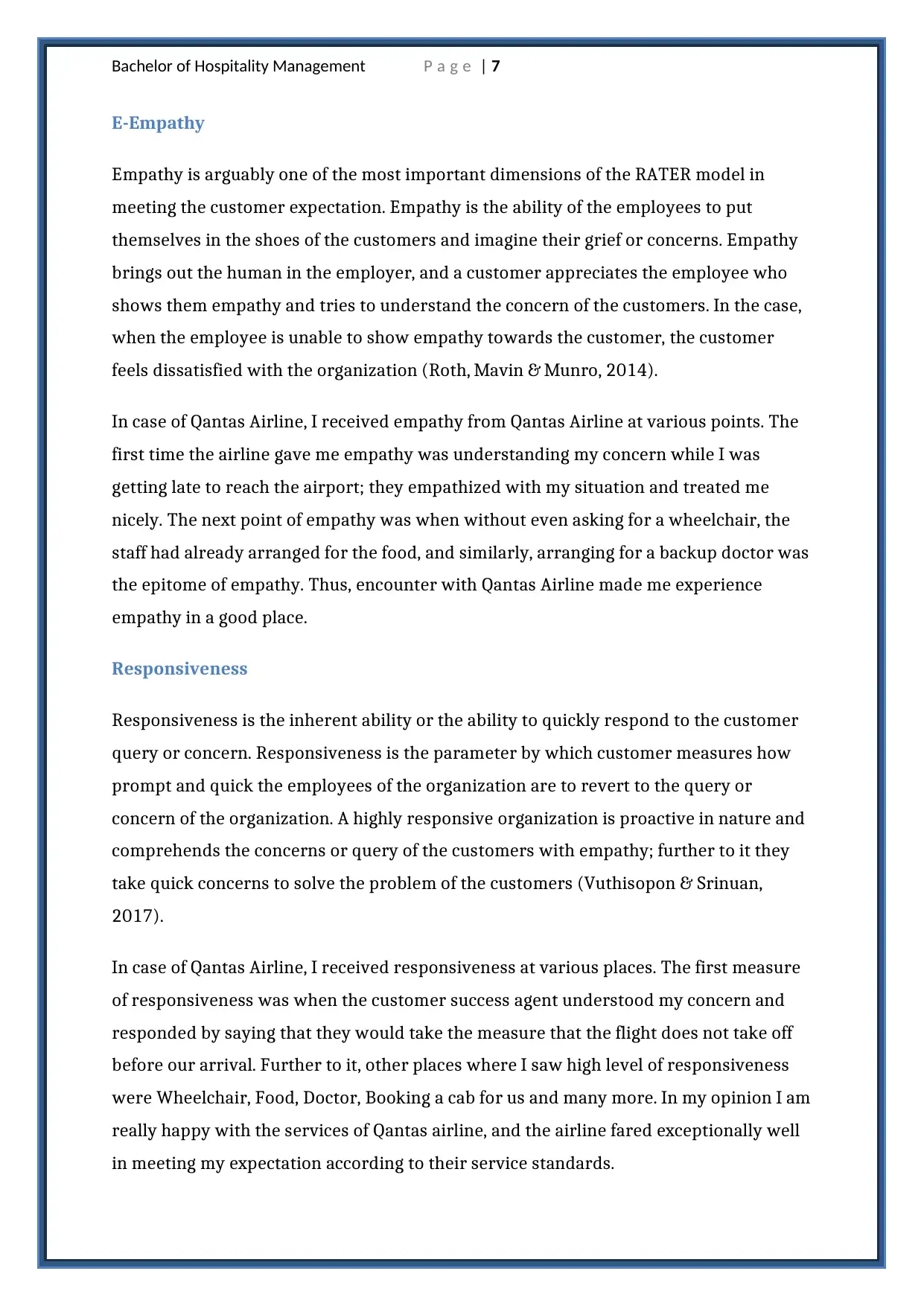
Bachelor of Hospitality Management P a g e | 7
E-Empathy
Empathy is arguably one of the most important dimensions of the RATER model in
meeting the customer expectation. Empathy is the ability of the employees to put
themselves in the shoes of the customers and imagine their grief or concerns. Empathy
brings out the human in the employer, and a customer appreciates the employee who
shows them empathy and tries to understand the concern of the customers. In the case,
when the employee is unable to show empathy towards the customer, the customer
feels dissatisfied with the organization (Roth, Mavin & Munro, 2014).
In case of Qantas Airline, I received empathy from Qantas Airline at various points. The
first time the airline gave me empathy was understanding my concern while I was
getting late to reach the airport; they empathized with my situation and treated me
nicely. The next point of empathy was when without even asking for a wheelchair, the
staff had already arranged for the food, and similarly, arranging for a backup doctor was
the epitome of empathy. Thus, encounter with Qantas Airline made me experience
empathy in a good place.
Responsiveness
Responsiveness is the inherent ability or the ability to quickly respond to the customer
query or concern. Responsiveness is the parameter by which customer measures how
prompt and quick the employees of the organization are to revert to the query or
concern of the organization. A highly responsive organization is proactive in nature and
comprehends the concerns or query of the customers with empathy; further to it they
take quick concerns to solve the problem of the customers (Vuthisopon & Srinuan,
2017).
In case of Qantas Airline, I received responsiveness at various places. The first measure
of responsiveness was when the customer success agent understood my concern and
responded by saying that they would take the measure that the flight does not take off
before our arrival. Further to it, other places where I saw high level of responsiveness
were Wheelchair, Food, Doctor, Booking a cab for us and many more. In my opinion I am
really happy with the services of Qantas airline, and the airline fared exceptionally well
in meeting my expectation according to their service standards.
E-Empathy
Empathy is arguably one of the most important dimensions of the RATER model in
meeting the customer expectation. Empathy is the ability of the employees to put
themselves in the shoes of the customers and imagine their grief or concerns. Empathy
brings out the human in the employer, and a customer appreciates the employee who
shows them empathy and tries to understand the concern of the customers. In the case,
when the employee is unable to show empathy towards the customer, the customer
feels dissatisfied with the organization (Roth, Mavin & Munro, 2014).
In case of Qantas Airline, I received empathy from Qantas Airline at various points. The
first time the airline gave me empathy was understanding my concern while I was
getting late to reach the airport; they empathized with my situation and treated me
nicely. The next point of empathy was when without even asking for a wheelchair, the
staff had already arranged for the food, and similarly, arranging for a backup doctor was
the epitome of empathy. Thus, encounter with Qantas Airline made me experience
empathy in a good place.
Responsiveness
Responsiveness is the inherent ability or the ability to quickly respond to the customer
query or concern. Responsiveness is the parameter by which customer measures how
prompt and quick the employees of the organization are to revert to the query or
concern of the organization. A highly responsive organization is proactive in nature and
comprehends the concerns or query of the customers with empathy; further to it they
take quick concerns to solve the problem of the customers (Vuthisopon & Srinuan,
2017).
In case of Qantas Airline, I received responsiveness at various places. The first measure
of responsiveness was when the customer success agent understood my concern and
responded by saying that they would take the measure that the flight does not take off
before our arrival. Further to it, other places where I saw high level of responsiveness
were Wheelchair, Food, Doctor, Booking a cab for us and many more. In my opinion I am
really happy with the services of Qantas airline, and the airline fared exceptionally well
in meeting my expectation according to their service standards.
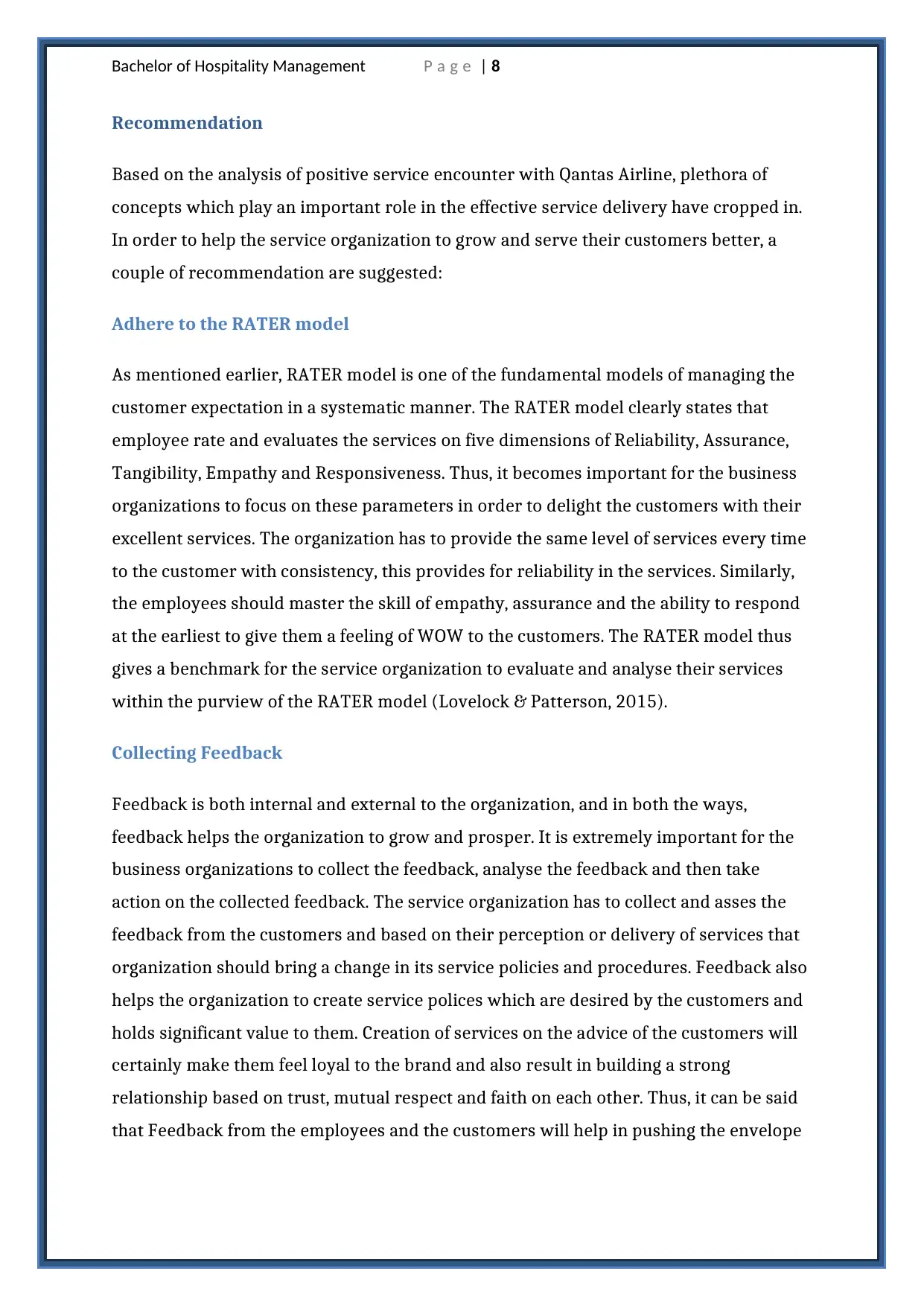
Bachelor of Hospitality Management P a g e | 8
Recommendation
Based on the analysis of positive service encounter with Qantas Airline, plethora of
concepts which play an important role in the effective service delivery have cropped in.
In order to help the service organization to grow and serve their customers better, a
couple of recommendation are suggested:
Adhere to the RATER model
As mentioned earlier, RATER model is one of the fundamental models of managing the
customer expectation in a systematic manner. The RATER model clearly states that
employee rate and evaluates the services on five dimensions of Reliability, Assurance,
Tangibility, Empathy and Responsiveness. Thus, it becomes important for the business
organizations to focus on these parameters in order to delight the customers with their
excellent services. The organization has to provide the same level of services every time
to the customer with consistency, this provides for reliability in the services. Similarly,
the employees should master the skill of empathy, assurance and the ability to respond
at the earliest to give them a feeling of WOW to the customers. The RATER model thus
gives a benchmark for the service organization to evaluate and analyse their services
within the purview of the RATER model (Lovelock & Patterson, 2015).
Collecting Feedback
Feedback is both internal and external to the organization, and in both the ways,
feedback helps the organization to grow and prosper. It is extremely important for the
business organizations to collect the feedback, analyse the feedback and then take
action on the collected feedback. The service organization has to collect and asses the
feedback from the customers and based on their perception or delivery of services that
organization should bring a change in its service policies and procedures. Feedback also
helps the organization to create service polices which are desired by the customers and
holds significant value to them. Creation of services on the advice of the customers will
certainly make them feel loyal to the brand and also result in building a strong
relationship based on trust, mutual respect and faith on each other. Thus, it can be said
that Feedback from the employees and the customers will help in pushing the envelope
Recommendation
Based on the analysis of positive service encounter with Qantas Airline, plethora of
concepts which play an important role in the effective service delivery have cropped in.
In order to help the service organization to grow and serve their customers better, a
couple of recommendation are suggested:
Adhere to the RATER model
As mentioned earlier, RATER model is one of the fundamental models of managing the
customer expectation in a systematic manner. The RATER model clearly states that
employee rate and evaluates the services on five dimensions of Reliability, Assurance,
Tangibility, Empathy and Responsiveness. Thus, it becomes important for the business
organizations to focus on these parameters in order to delight the customers with their
excellent services. The organization has to provide the same level of services every time
to the customer with consistency, this provides for reliability in the services. Similarly,
the employees should master the skill of empathy, assurance and the ability to respond
at the earliest to give them a feeling of WOW to the customers. The RATER model thus
gives a benchmark for the service organization to evaluate and analyse their services
within the purview of the RATER model (Lovelock & Patterson, 2015).
Collecting Feedback
Feedback is both internal and external to the organization, and in both the ways,
feedback helps the organization to grow and prosper. It is extremely important for the
business organizations to collect the feedback, analyse the feedback and then take
action on the collected feedback. The service organization has to collect and asses the
feedback from the customers and based on their perception or delivery of services that
organization should bring a change in its service policies and procedures. Feedback also
helps the organization to create service polices which are desired by the customers and
holds significant value to them. Creation of services on the advice of the customers will
certainly make them feel loyal to the brand and also result in building a strong
relationship based on trust, mutual respect and faith on each other. Thus, it can be said
that Feedback from the employees and the customers will help in pushing the envelope
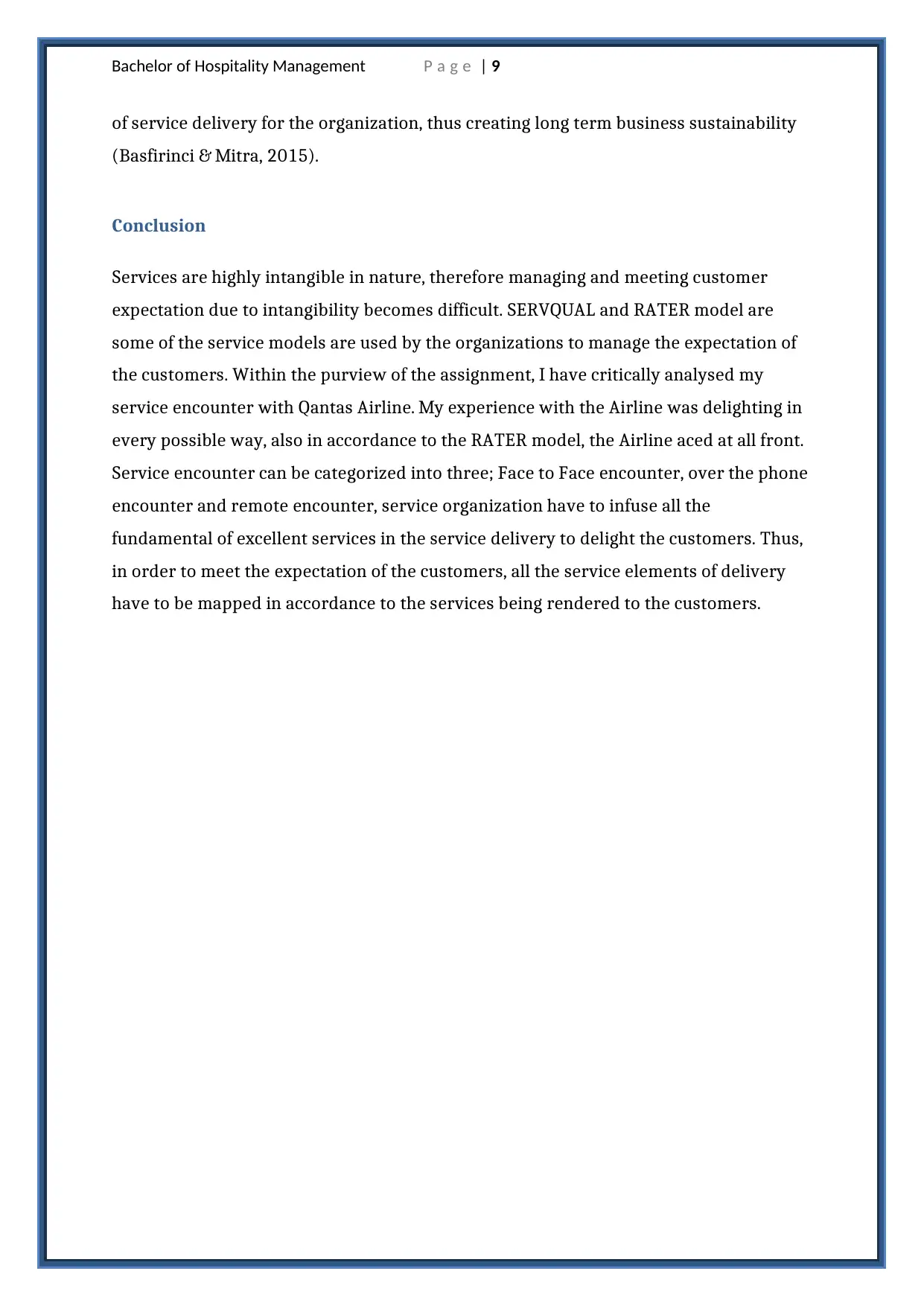
Bachelor of Hospitality Management P a g e | 9
of service delivery for the organization, thus creating long term business sustainability
(Basfirinci & Mitra, 2015).
Conclusion
Services are highly intangible in nature, therefore managing and meeting customer
expectation due to intangibility becomes difficult. SERVQUAL and RATER model are
some of the service models are used by the organizations to manage the expectation of
the customers. Within the purview of the assignment, I have critically analysed my
service encounter with Qantas Airline. My experience with the Airline was delighting in
every possible way, also in accordance to the RATER model, the Airline aced at all front.
Service encounter can be categorized into three; Face to Face encounter, over the phone
encounter and remote encounter, service organization have to infuse all the
fundamental of excellent services in the service delivery to delight the customers. Thus,
in order to meet the expectation of the customers, all the service elements of delivery
have to be mapped in accordance to the services being rendered to the customers.
of service delivery for the organization, thus creating long term business sustainability
(Basfirinci & Mitra, 2015).
Conclusion
Services are highly intangible in nature, therefore managing and meeting customer
expectation due to intangibility becomes difficult. SERVQUAL and RATER model are
some of the service models are used by the organizations to manage the expectation of
the customers. Within the purview of the assignment, I have critically analysed my
service encounter with Qantas Airline. My experience with the Airline was delighting in
every possible way, also in accordance to the RATER model, the Airline aced at all front.
Service encounter can be categorized into three; Face to Face encounter, over the phone
encounter and remote encounter, service organization have to infuse all the
fundamental of excellent services in the service delivery to delight the customers. Thus,
in order to meet the expectation of the customers, all the service elements of delivery
have to be mapped in accordance to the services being rendered to the customers.
Secure Best Marks with AI Grader
Need help grading? Try our AI Grader for instant feedback on your assignments.
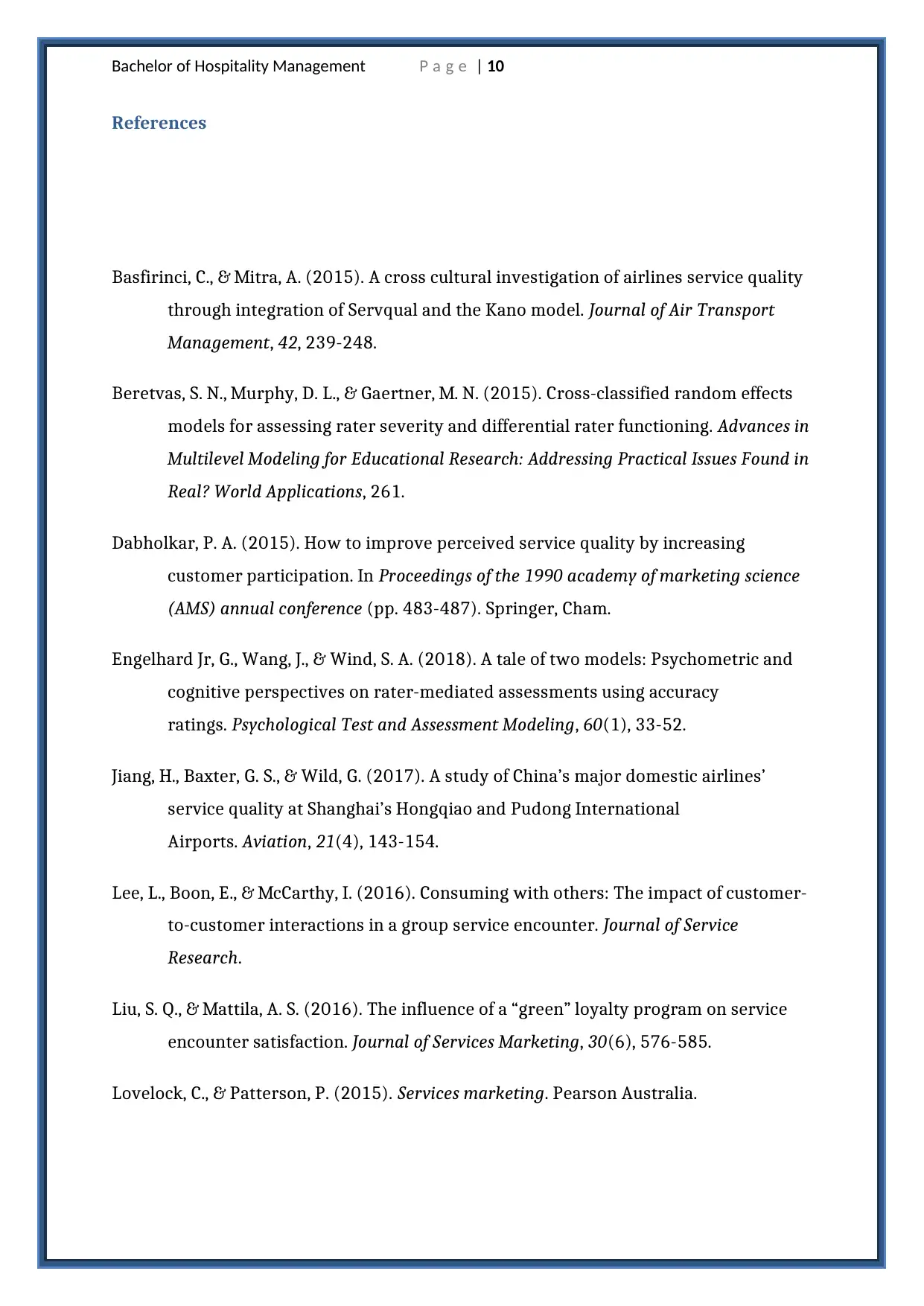
Bachelor of Hospitality Management P a g e | 10
References
Basfirinci, C., & Mitra, A. (2015). A cross cultural investigation of airlines service quality
through integration of Servqual and the Kano model. Journal of Air Transport
Management, 42, 239-248.
Beretvas, S. N., Murphy, D. L., & Gaertner, M. N. (2015). Cross-classified random effects
models for assessing rater severity and differential rater functioning. Advances in
Multilevel Modeling for Educational Research: Addressing Practical Issues Found in
Real? World Applications, 261.
Dabholkar, P. A. (2015). How to improve perceived service quality by increasing
customer participation. In Proceedings of the 1990 academy of marketing science
(AMS) annual conference (pp. 483-487). Springer, Cham.
Engelhard Jr, G., Wang, J., & Wind, S. A. (2018). A tale of two models: Psychometric and
cognitive perspectives on rater-mediated assessments using accuracy
ratings. Psychological Test and Assessment Modeling, 60(1), 33-52.
Jiang, H., Baxter, G. S., & Wild, G. (2017). A study of China’s major domestic airlines’
service quality at Shanghai’s Hongqiao and Pudong International
Airports. Aviation, 21(4), 143-154.
Lee, L., Boon, E., & McCarthy, I. (2016). Consuming with others: The impact of customer-
to-customer interactions in a group service encounter. Journal of Service
Research.
Liu, S. Q., & Mattila, A. S. (2016). The influence of a “green” loyalty program on service
encounter satisfaction. Journal of Services Marketing, 30(6), 576-585.
Lovelock, C., & Patterson, P. (2015). Services marketing. Pearson Australia.
References
Basfirinci, C., & Mitra, A. (2015). A cross cultural investigation of airlines service quality
through integration of Servqual and the Kano model. Journal of Air Transport
Management, 42, 239-248.
Beretvas, S. N., Murphy, D. L., & Gaertner, M. N. (2015). Cross-classified random effects
models for assessing rater severity and differential rater functioning. Advances in
Multilevel Modeling for Educational Research: Addressing Practical Issues Found in
Real? World Applications, 261.
Dabholkar, P. A. (2015). How to improve perceived service quality by increasing
customer participation. In Proceedings of the 1990 academy of marketing science
(AMS) annual conference (pp. 483-487). Springer, Cham.
Engelhard Jr, G., Wang, J., & Wind, S. A. (2018). A tale of two models: Psychometric and
cognitive perspectives on rater-mediated assessments using accuracy
ratings. Psychological Test and Assessment Modeling, 60(1), 33-52.
Jiang, H., Baxter, G. S., & Wild, G. (2017). A study of China’s major domestic airlines’
service quality at Shanghai’s Hongqiao and Pudong International
Airports. Aviation, 21(4), 143-154.
Lee, L., Boon, E., & McCarthy, I. (2016). Consuming with others: The impact of customer-
to-customer interactions in a group service encounter. Journal of Service
Research.
Liu, S. Q., & Mattila, A. S. (2016). The influence of a “green” loyalty program on service
encounter satisfaction. Journal of Services Marketing, 30(6), 576-585.
Lovelock, C., & Patterson, P. (2015). Services marketing. Pearson Australia.
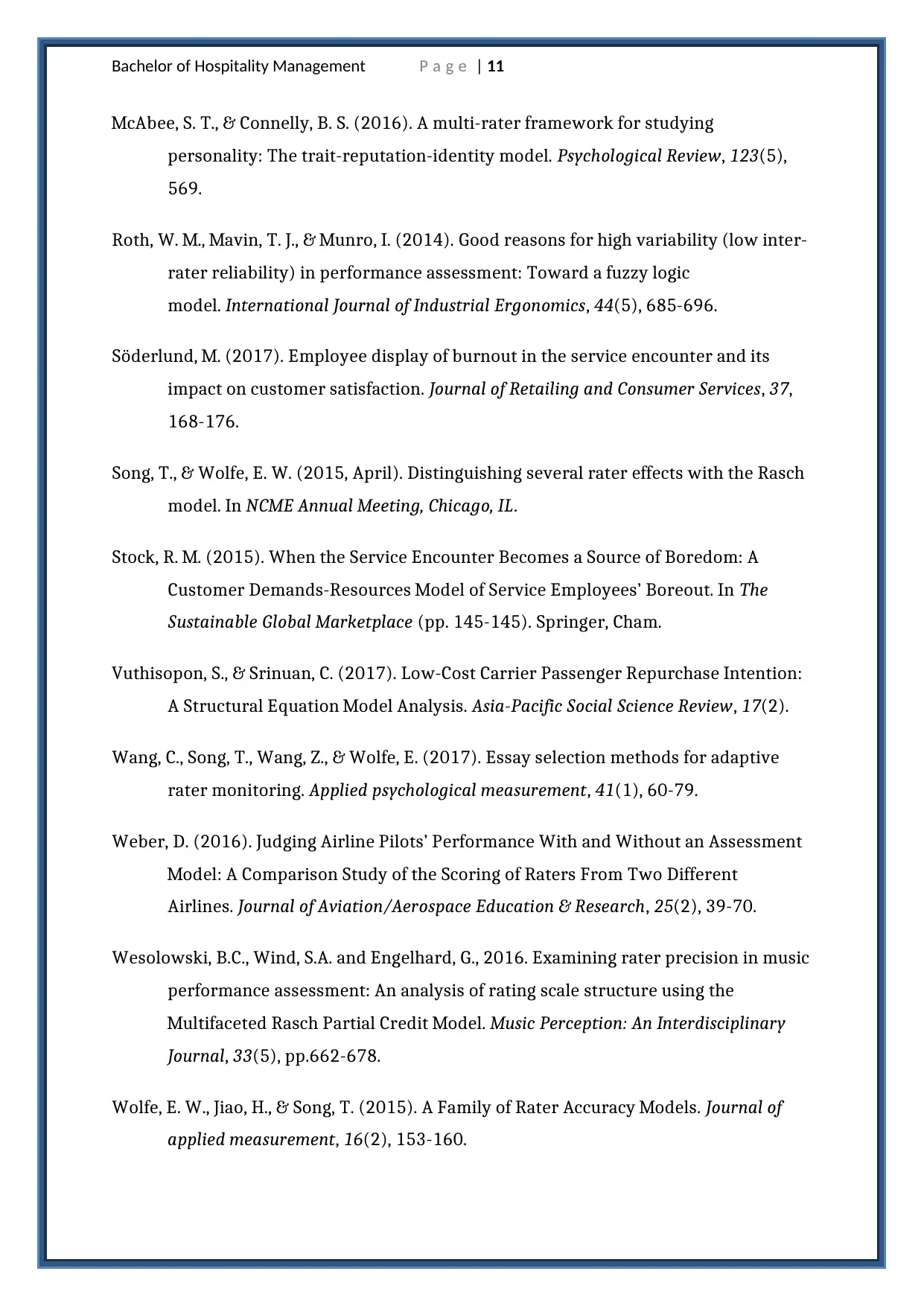
Bachelor of Hospitality Management P a g e | 11
McAbee, S. T., & Connelly, B. S. (2016). A multi-rater framework for studying
personality: The trait-reputation-identity model. Psychological Review, 123(5),
569.
Roth, W. M., Mavin, T. J., & Munro, I. (2014). Good reasons for high variability (low inter-
rater reliability) in performance assessment: Toward a fuzzy logic
model. International Journal of Industrial Ergonomics, 44(5), 685-696.
Söderlund, M. (2017). Employee display of burnout in the service encounter and its
impact on customer satisfaction. Journal of Retailing and Consumer Services, 37,
168-176.
Song, T., & Wolfe, E. W. (2015, April). Distinguishing several rater effects with the Rasch
model. In NCME Annual Meeting, Chicago, IL.
Stock, R. M. (2015). When the Service Encounter Becomes a Source of Boredom: A
Customer Demands-Resources Model of Service Employees’ Boreout. In The
Sustainable Global Marketplace (pp. 145-145). Springer, Cham.
Vuthisopon, S., & Srinuan, C. (2017). Low-Cost Carrier Passenger Repurchase Intention:
A Structural Equation Model Analysis. Asia-Pacific Social Science Review, 17(2).
Wang, C., Song, T., Wang, Z., & Wolfe, E. (2017). Essay selection methods for adaptive
rater monitoring. Applied psychological measurement, 41(1), 60-79.
Weber, D. (2016). Judging Airline Pilots’ Performance With and Without an Assessment
Model: A Comparison Study of the Scoring of Raters From Two Different
Airlines. Journal of Aviation/Aerospace Education & Research, 25(2), 39-70.
Wesolowski, B.C., Wind, S.A. and Engelhard, G., 2016. Examining rater precision in music
performance assessment: An analysis of rating scale structure using the
Multifaceted Rasch Partial Credit Model. Music Perception: An Interdisciplinary
Journal, 33(5), pp.662-678.
Wolfe, E. W., Jiao, H., & Song, T. (2015). A Family of Rater Accuracy Models. Journal of
applied measurement, 16(2), 153-160.
McAbee, S. T., & Connelly, B. S. (2016). A multi-rater framework for studying
personality: The trait-reputation-identity model. Psychological Review, 123(5),
569.
Roth, W. M., Mavin, T. J., & Munro, I. (2014). Good reasons for high variability (low inter-
rater reliability) in performance assessment: Toward a fuzzy logic
model. International Journal of Industrial Ergonomics, 44(5), 685-696.
Söderlund, M. (2017). Employee display of burnout in the service encounter and its
impact on customer satisfaction. Journal of Retailing and Consumer Services, 37,
168-176.
Song, T., & Wolfe, E. W. (2015, April). Distinguishing several rater effects with the Rasch
model. In NCME Annual Meeting, Chicago, IL.
Stock, R. M. (2015). When the Service Encounter Becomes a Source of Boredom: A
Customer Demands-Resources Model of Service Employees’ Boreout. In The
Sustainable Global Marketplace (pp. 145-145). Springer, Cham.
Vuthisopon, S., & Srinuan, C. (2017). Low-Cost Carrier Passenger Repurchase Intention:
A Structural Equation Model Analysis. Asia-Pacific Social Science Review, 17(2).
Wang, C., Song, T., Wang, Z., & Wolfe, E. (2017). Essay selection methods for adaptive
rater monitoring. Applied psychological measurement, 41(1), 60-79.
Weber, D. (2016). Judging Airline Pilots’ Performance With and Without an Assessment
Model: A Comparison Study of the Scoring of Raters From Two Different
Airlines. Journal of Aviation/Aerospace Education & Research, 25(2), 39-70.
Wesolowski, B.C., Wind, S.A. and Engelhard, G., 2016. Examining rater precision in music
performance assessment: An analysis of rating scale structure using the
Multifaceted Rasch Partial Credit Model. Music Perception: An Interdisciplinary
Journal, 33(5), pp.662-678.
Wolfe, E. W., Jiao, H., & Song, T. (2015). A Family of Rater Accuracy Models. Journal of
applied measurement, 16(2), 153-160.
1 out of 12
Your All-in-One AI-Powered Toolkit for Academic Success.
+13062052269
info@desklib.com
Available 24*7 on WhatsApp / Email
![[object Object]](/_next/static/media/star-bottom.7253800d.svg)
Unlock your academic potential
© 2024 | Zucol Services PVT LTD | All rights reserved.


